#holghras
Explore tagged Tumblr posts
Text
Bestiaryposting: Holghras Results
Now for what everyone -- or at least a certain percentage -- has been waiting for: the results for the Holghras! Anyone who found that sentence confusing can catch up by checking this page: https://maniculum.tumblr.com/bestiaryposting .
This time around, they should all fit into one post, as the response was a little smaller. I see how it is: everyone wants to draw Spooky Corpse-Eater With Magic, but nobody wants to draw Horny Bird With Problems.
I kid, of course. The Wutugald had some pretty clear visual elements that people could hook onto, but the Holghras entry is mostly about its behavior and doesn't give much information on what it looks like beyond "it's a bird". So it's pretty clear why people might have a harder time drawing artistic inspiration from that one. (And I really and truly appreciate those of you who took a crack at it anyway.) The level of physical description is going to vary a lot entry to entry, I'm afraid -- to some extent I think it's about whether it's an animal the reader is expected to be familiar with, but there are definitely a few detailed visual descriptions of animals most medieval Europeans would have seen because the author wants to do some symbolism. So it's a toss-up. Anyway, here's the link to the description people are working from:
And the results, again roughly in order of appearance. If yours isn't here, let me know -- I saw one post that said something about Tumblr eating their original attempt, presumably out of Bird Homophobia. I'm happy to reblog any that I missed due to Tumblr's functionality.

@bruncikara (link to post here) gives us our first interpretation. I really enjoy the medieval bestiary style, including the use of the Generic Medieval Plant that always reminds me of mutant asparagus. I think the border is designed to evoke the thorns in which the Holghras nests, which I also appreciate. The bird's pose, flat on its back with its neck curved up, is great, and it's shown performing its signature Hide With Dirt move. I think at least some of the inspiration comes from quails here, judging by the head... feather... thing... [Wikipedia break] ... okay, apparently it's just called a "plume", which I should have guessed. This is the first example of the common (and correct!) assumption that the Holghras is a member of the order Galliformes.
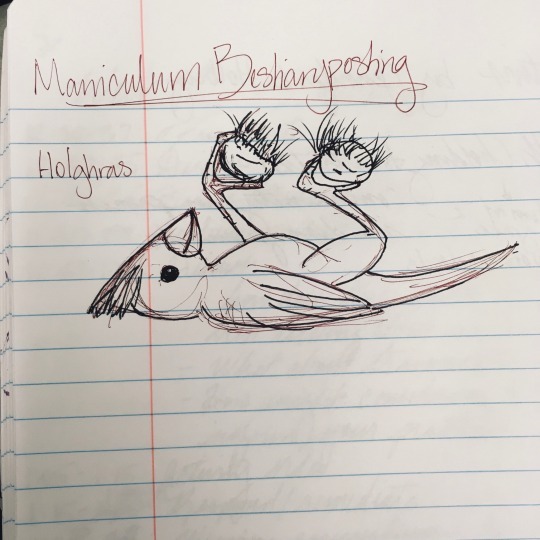
@jamiethekeener (link to post here) gives us this one, also posing with its signature dirt clods. I'm reminded of a cardinal, personally. The artist provides a brief comment on their design, noting that they are not a bird expert. I think this is a pretty cute juvenile bird, and the way it holds the dirt comes off as kind of playful.
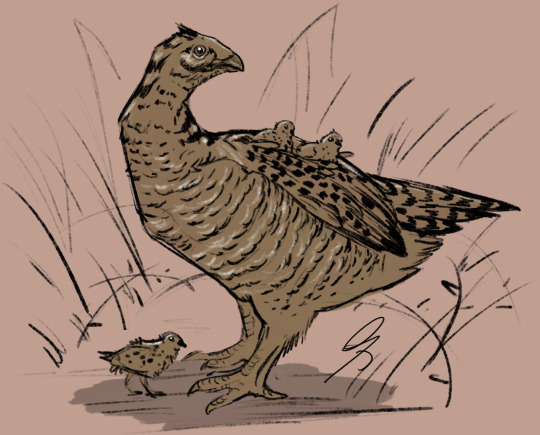
@silverhart-makes-art (link to post here) has produced another very naturalistic drawing, which (in my non-expert opinion) manages to look very much like a real bird without specifically looking like any bird in particular. They apparently do know birds, because they specifically name-drop Galliformes in their description of their design decisions. I like the decision to also include one of the bird's Signature Behaviors, i.e., the mother carrying her chicks.
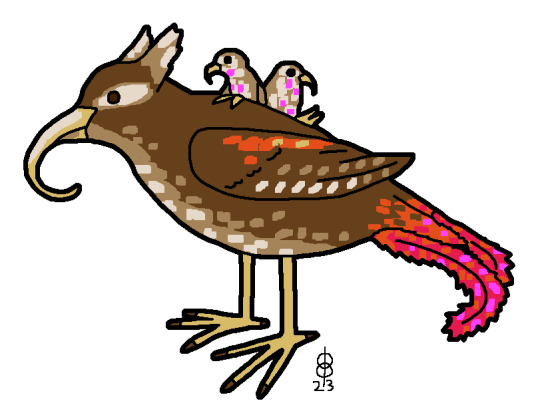
@pomrania (link to post here) has given their Holghras a selection of striking features, which they explain in their post. There's a lot in that post, actually, and I really enjoyed reading the whole journey of this particular drawing. You should go read it too -- the post linked above also provides a draft version, a link to a series of progress sketches, and a link to an explanation of their design choices that includes rumination on how to make a bird look "slutty". Go check it out, we'll be here when you get back.
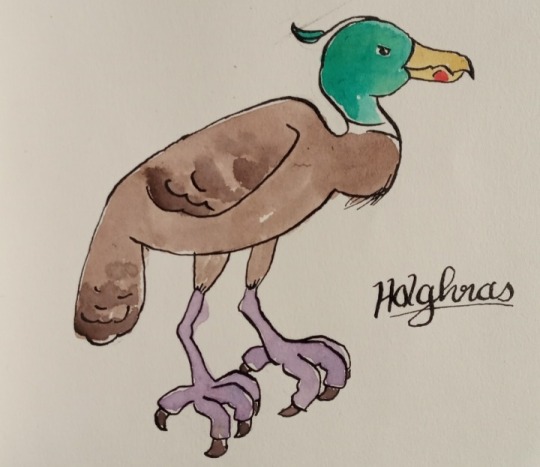
@sweetlyfez (link to post here) describes her design choices briefly, indicating that her goal was to pick Bird Attributes that could look unsettling in combination and suggest that the bird depicted has a "terrible sex life". Mission accomplished, I think -- that bird does not look trustworthy. Also now we know that thing on its head is just called a plume, so good for us. I really like the effect the -- watercolor? I think? I don't know art -- provides, and that seagull-esque spot on its beak really is a great touch.
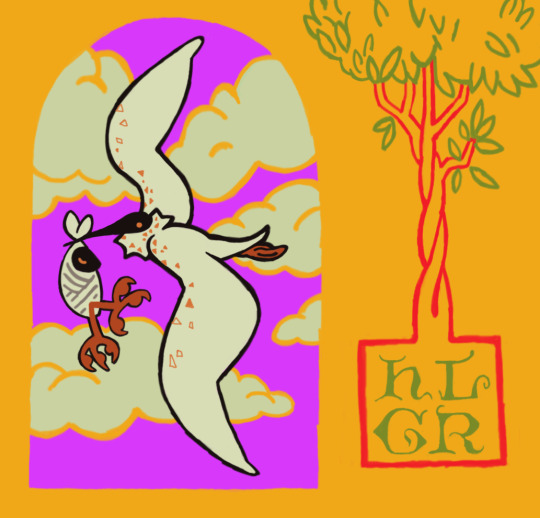
@rautavaara (link to post here) has done another beautifully stylized drawing with a very pleasant color scheme. They provide a brief explanation of their design decisions in the linked post. I'm particularly struck by the fact that this version of the Holghras apparently carries its young in the same way that the folkloric version of the stork carries babies: in some kind of cloth wrapping held in the beak. I also like that the chick's feet are sticking out.
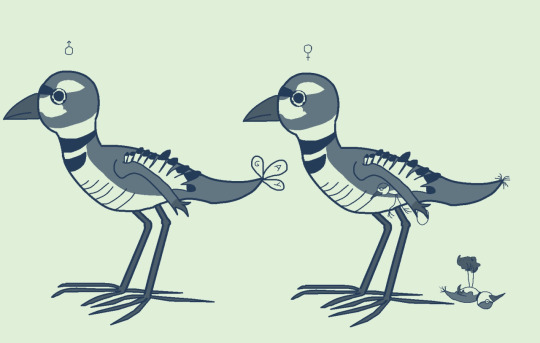
@mobileleprechaun (link to post here) apparently had some trouble posting this, but I'm glad they got it through, because it's delightful. I like the little bird on the right with its feet sticking straight up, and the other one under its mother's wing/arm. When I first saw this, I was briefly puzzled why the drawing contrasted male and female birds, because they looked quite similar -- then I noticed the tailfeathers -- then I looked more closely at the male's tailfeathers and cracked up a little bit. The linked post provides a brief explanation of the design decisions, including why the wings look so much like arms. It also has a couple tags that I find funny.
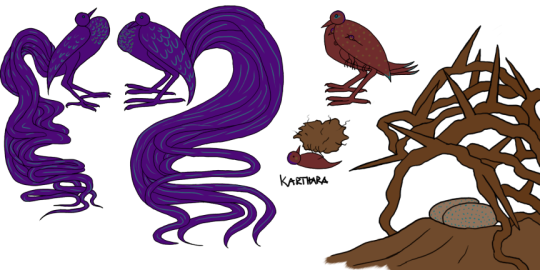
@karthara (link to post here) provides this excellent image as well as a brief explanation of their design choices. I love the over-the-top tailfeathers on the extremely-sexy purple male Holghrases, and the babies dangling from under the female's wing, and the fact that the clod of dirt being held up by the juvenile is at least as big as the bird holding it. Also, those ridiculous tailfeathers are apparently inspired by the Onagadori rooster, which means we're back with the Galliformes.

@embervoices (link to post here) did this adorable drawing of the juvenile Holghras. I particularly like that she's taken a different route than having it just hold up the dirt: this one apparently has a little hidey-hole like a trapdoor spider. This is just very cute all around, I like it.

@cheapsweets (link to post here) provides this excellent and action-packed depiction, along with a wonderfully detailed explanation of their design decisions. (I love reading those.) From their post, it's clear that they also know more about birds than I do, and also name-check the Galliformes as the most likely category. Apparently the bird-people of Tumblr have this critter's number. Also, that is a masterful depiction of a bird running off with an egg, I have to say.
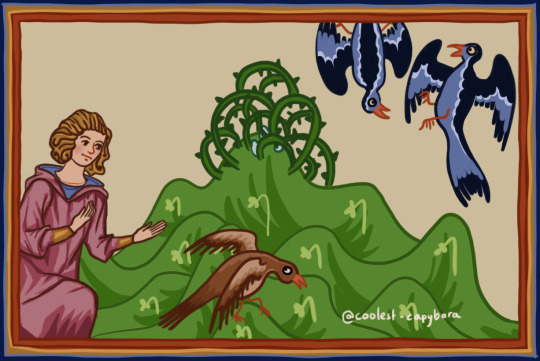
@coolest-capybara (link to post here) has done another medieval-styled rendition, which I really enjoy. This is also, I believe, the first appearance of a human in any of these drawings. (Well. Live human, at least.) I enjoy the depiction of the female bird doing her fake limp to lead the human away from her nest while the males engage in their weird drama up in the right. They provide an explanation of their design choices and inspiration in the linked post.

@scarlettbookworm (link to post here) has given us a drawing that showcases several of the odd behaviors described in the entry. The linked post also provides a description of their design process and an explanation of their decisions. I think this is another very cute picture of a bird holding up dirt, and I enjoy the one at the top shouting "HOLGHRAS!" The egg-stealer over in the bottom right is very good also.

@moustawott (link to post here) has drawn this very vulture-like Holghras in what I have to say is a very well-done bushy area. I had to look twice to realize the background was actually cleverly-arranged splashes and blobs of color that strongly suggest that we're in a bush. Very good art, love the style, and that fuzzy baby Holghras is cute as hell. The linked post provides an explanation of the design decisions.
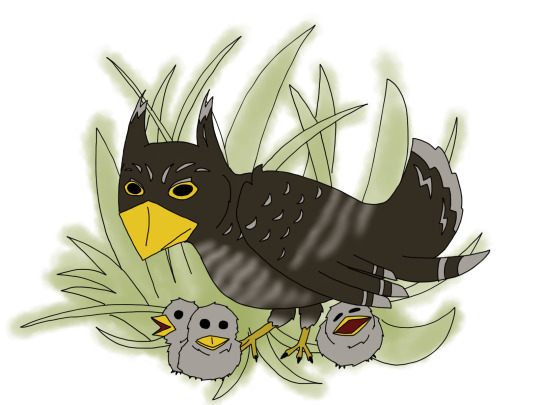
@strixcattus (link to post here) gives us this rendition of the Holghras, which they describe as being inspired by a prairie chicken and a potoo. Prairie chickens are, of course... Galliformes. Another tally mark in that column. I'm particularly delighted by the giant mouth on the chick in the bottom right. As they did last time, the artist has provided a detailed modern-naturalist interpretation of the animal, which is of course in the linked post. I recommend checking that out; maybe it's just because I'm the kind of huge nerd that I am, but I think these are great.
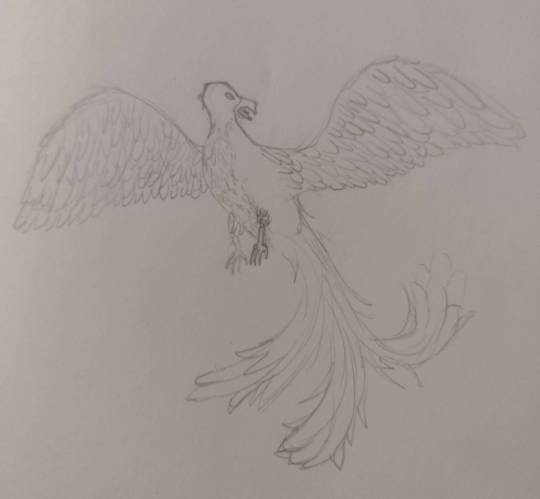
@treesurface (link to post here) gives us a Holghras that they describe as a cross between a bird of prey and a bird of paradise, which I think is a pretty good idea that fits both the aggressive behavior and the mating behavior described in the entry. I enjoy the fact that multiple artists have decided this bird Likes Big Tailfeathers (and it does lie, but about different things).
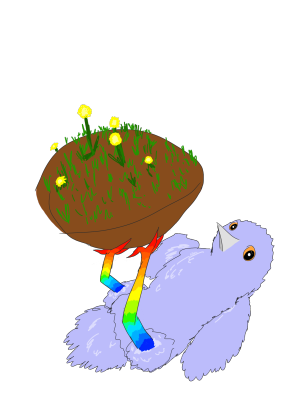
@ashfly (link to post here) gives us this picture of a juvenile Holghras holding up its clump of dirt. They also indicate that they have an idea of what it is, which I really hope they'll share now that it's posted and the bird's out of the bag, because I was 100% certain nobody would guess this one. The fuzzy bird is cute, of course, and the rainbow legs are really striking. (Pride legs, perhaps?) I also like that it's clearly looking over at the "camera" to see if we're buying it.
And finally, the official medieval depiction:

... hm. Yeah, some absolute bastard apparently cut out a bunch of the miniatures in this manuscript at one point. Luckily, we have the Ashmole Bestiary over at the Bodleian Library, which is extremely similar, so we can get an idea of the image that was here:
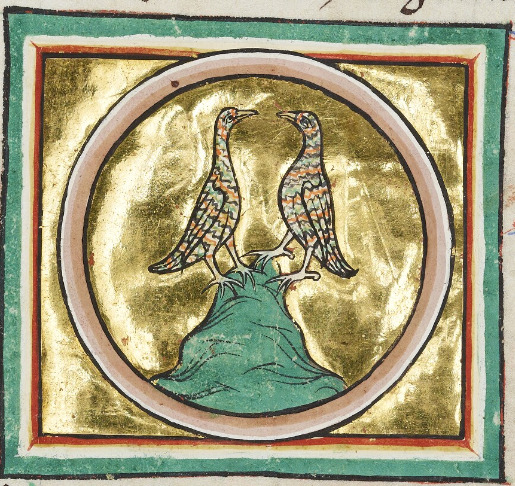
And also, this entry in the Aberdeen Bestiary comes with two images. Here's the other one:

I'm going to assume the choice of coloration was up to the individual artist and the missing Aberdeen illustration was also brown, because the Ashmole version of the egg-stealer also has the more colorful pattern:
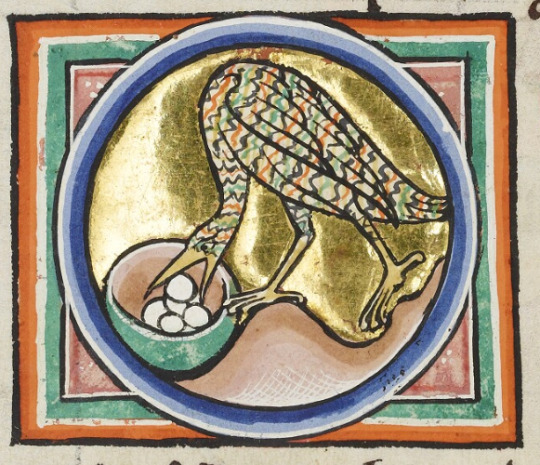
Anyway, in case you haven't recognized it from these helpful and very accurate images, this is the partridge. Now you know what's going on in those pear trees.
I don't actually have anything else to add about that. I was frankly a little surprised there was even an entry for "partridge".
67 notes
·
View notes
Text
"The ever-productive Holghras. Each turn it lays another egg for you to use as sacrifice."


Still wondering if I should have made this a 2-health instead of 3 for balance, but a 1/2 for two blood is... not great. It feels a little silly that this card is Airborne, though it is a flight-capable bird. The fun here comes from its unique sigil:
Brood Mother: At the start of your turn, add a Holghras Egg to your hand. A Holghras Egg is defined as: 0 Power, 1 Health, Fledgling.
"Do take good care of it, won't you?"




Unlike most Fledgeling cards, Holghras Eggs and Holghras Chicks can only be gained through the Brood Mother sigil—they aren't available from card drops.
I'm spinning the idea of a hidden interaction between Brood Mother and Brood Parasite, where if you have both sigils on the board, there's a small chance you add a Cuckoo to your hand instead of a Holghras Egg. It feels fitting with Brood Parasite.
Holghras Eggs carry over any sigil patches added to the card that creates them, the same as Bees or Rabbits, which makes for some fun combinations. Worthy Sacrifice or Bone King might be a good use, especially if you can set the Holghras up somewhere safe, or you could use Unkillable to get your (free!) Holghras Chicks back on the board if they die before they can finish maturing, giving you easy access to... more Holghras Eggs. Personally, though, I'd have to go with Trinket Bearer—but that's my answer to everything, so...
7 notes
·
View notes
Text
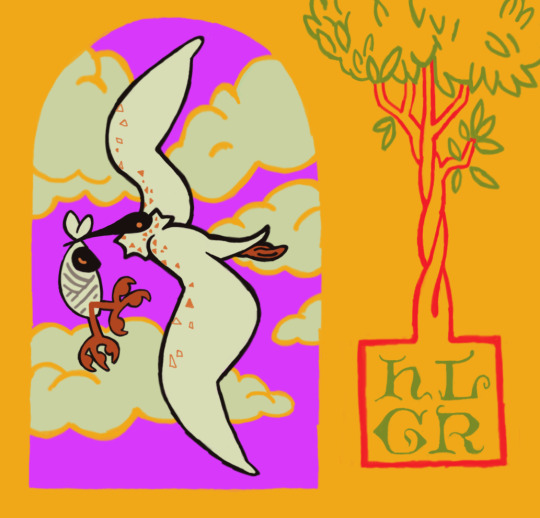
A female Holghras carrying its young. For the second week of the ongoing bestiary event. An animal described for its senses of smell, hearing, intelligence, navigation, as well as its certain uncleanity.
Brown spots to indicate the male scent caught on by the feathers, as well as and impression of disease. Spiky collar to indicate sensory experience. As well there is, the juvenile, with its big feet, that it can wisely and instinctually use.
50 notes
·
View notes
Text

Bestiary Posting Number #2! (I think I forgot to say last time why I'm posting weird critters and it's for @maniculum's Bestiary Posting.)
This here is the Holghras. There's very little physical description of this animal, so I just went off some clues. It's a bird, so that's a good place to start. It covers it's nest in dust, and it's young hide using dirt, so that makes me think it's a bird that nests on the ground. And since the author mentions males mounting other males, it seems to me that males and females must be easily distinguished from each other. So I went for a galliform bird, since they are typically groundbirds, polygamous, and males and females tend to look very different.
Honestly, kind of stumped on what this bird could actually be. If pressed I could muster some guesses. The description mentions the mother carrying her chicks, so I decided to depict that here, taking inspiration from how some waterfowl carry their chicks on their backs.
24 notes
·
View notes
Text

It’s a baby with dirt clods! I don’t know enough about birds to explain the beak…berries from…thorn bushes? Although that might require a longer beak actually.
#I also didn’t know how to depict horniness in birds#plumage I guess#holghras#maniculum bestiaryposting
12 notes
·
View notes
Text
I almost didn’t make it in time 😭 But I still managed to draw the holghras! Done for the #bestiaryposting challenge by @/maniculum

Because the description wasn’t very detailed, I mostly drew something very simple and conventional 😅
The stealing eggs and being a cunning and unclean bird made me think or corvids, so my main inspiration here was the crow! But I didn’t want to make it too ordinary, so I pulled from the tick-billed raven for the face and had a vulture for the body to emphasize how "unclean" of a bird it might be. I’ve also tried to picture how inside the thorny bushes their nest would look, but I was too lazy to actually render the thorns, oops
12 notes
·
View notes
Text
The indecorous Holghras
My response to this week's Bestiaryposting challenge from The Maniculum!
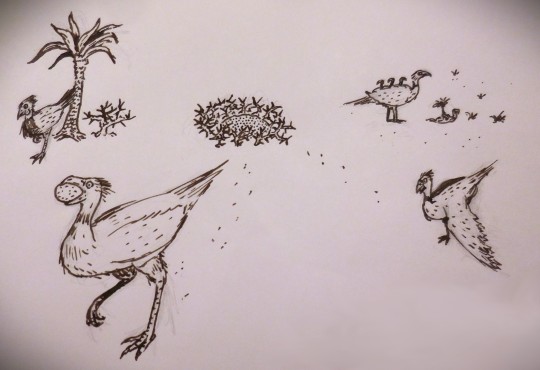
The style here is less specifically bestiary influenced than my previous entry (I've had to hide my copies of bestiaries in the house, in case I get spoiled - I'm pretty sure I remember reading something like this in one of them, but I can't remember exactly what it related to...), might try and switch back to more stylised art for next week.
Again, I'm very out of practice, so I appreciate the impetus to learn how to draw again (including composition, which I feel was one of the areas I struggled this week, and how to use a pen with a fude nib!)
Reasoning for the decisions below the cut...!
This was a tricky one, as the description was entirely related to behaviour, with no description of what this critter looked like (except for 'bird').
Most of the weird animals from medieval bestiaries and classical natural histories seem to be from the continent of Africa (and, fair; giraffes, okapis, aardvarks and elephant shrews, oh my!), so my immediate thought was for it to be a ratite; my main reason for changing this was because of the note about the mama bird pretending it had a broken wing (I'm not sure that would work with an ostritch!). I tried to keep the long legs, and figuring that if the mama birds also pretend to have injured legs/feet, it must still be a primarily ground-dwelling bird, so galliformes it is!
Taking the 'unlean' description more literally, I tried to think what sort of bird the writer of a medieval bestiary would describe as unclean. The obvious option there is vultures, so I've gone with a mostly bare head. At this point I couldn't help working in some elements of one of my favourite birds (honestly, look up guineafowl, they are awesome!), so amongst other things we have some wattles on the male Holghras looking on approvingly from next to a tree...
"one male mounts another and in their reckless lust they forget their sex. The Holghras is so deceitful that one will steal another's eggs." - This immediately made me think of the gay penguins from the Central Park Zoo in New York, but since penguins are strictly Southern Hemisphere in the wild, it seemed unlikely this was the inspiration for this critter! In the foreground, we see a crafty Holghras legging it with a stolen egg...!
"The nests built by Holghrases are skilfully fortified. For they cover their hiding-place with thorny bushes so that animals attacking them are kept at bay by the prickly branches. The Holghras uses dust to cover its eggs and returns secretly to the place, which it has marked." - Spot the mound of dirt covering the eggs in the next, surrounded by thorn bushes. I really should have looked up acacia before drawing this, as acacia thorns (and trees) are way different to what I was expecting!
"The females often carry their young" - Mum bird bus! I really should have made this the focus of the drawing, as this is by far the most fun (and cute) part of the description!
"if any man approaches the place where the Holghras is brooding, the mothers come out and deliberately show themselves to them; pretending that their feet or wings are injured, they put on a show of moving slowly, as if they could be caught in no time; by this trick they act as decoys to the approaching men and fool them into moving far away from the nest." - I recognise this behaviour from a lot of birds, notably, plovers; this hasn't done the mother of this clutch a lot of good, as she looks on indignantly as one of her neighbours is running off with one of her eggs!
"The young are not slow, either, to watch out for themselves. When they sense that they have been seen, they lie on their backs holding up small clods of earth in their claws, camouflaging themselves so skilfully, that they lie hidden from detection." - As noted above, I was initially thinking that the Holghras would be a ratite like an ostritch, so my mind went to the baby birds holding up clods of earth with grass in it, in one of their long legs, and pretending to be a small tree. It made me laugh, so I continued to roll with that, though as noted earlier I really should have made this more of a focus so I could have drawn it a lot bigger; I fear a lot of the potential details have been lost, but hopefully it gets across the general concept!
13 notes
·
View notes
Text

This kinda read as sexiest bird to ever sexy, and that got me thinking of pouter pigeons and other flashy displaying male birds, and I also remembered that shore bird that looked like it had way too many legs cause it was carrying its young under its wings. So enjoy this blend of pouter pigeon, Onagadori rooster, and Jacana bird. I also think the idea of the babies hiding by holding dirt clods is very cute. Also gave the chicks a dot on their cheek to match the females wings. Thorny dirt nest included.
14 notes
·
View notes
Text

Trying this again since it's frustratingly still invisible in the tags after a couple days:
Male, female and juvenile holghras. The description didn't say nothin' about them flying, so I dipped into the oviraptor inspiration jar just a smidge. Who's to say the true identity of this mystery bird isn't also misunderstood to be an egg thief?
#holghras#maniculum bestiaryposting#my art#headcanoning that tumblr is homophobic about the official Gay Lust Bird™️#i just want it to be... visible ya know?
9 notes
·
View notes
Text

The holghras. I didn't feel like the bestiary entry gave me much to inform the shape of this bird, so I've grabbed an assortment of unsettling parts in hopes of creating an overall unsettling bird.
It's a wader bc they have nesting habits similar to the description, and duck and seagull features bc they have terrible sex lives
#holghras#Drawing#bestiaryposting#Apparently otters also have terrible sex but theyre not birds in any definition#Fish sometimes but not birds
9 notes
·
View notes
Text
Bestiaryposting -- Holghras
Second creature in the bestiaryposting series. You can find previous posts at https://maniculum.tumblr.com/bestiaryposting . Do we need to do introductions for these or do y'all get the idea?
The Holghras gets its name from the sound it makes. It is a cunning and unclean bird. For one male mounts another and in their reckless lust they forget their sex. The Holghras is so deceitful that one will steal another's eggs. But the trick does not work. For when the young hear the cry of their real mother, their natural instinct is to leave the bird that is brooding them and return to the mother who produced them. The nests built by Holghrases are skilfully fortified. For they cover their hiding-place with thorny bushes so that animals attacking them are kept at bay by the prickly branches. The Holghras uses dust to cover its eggs and returns secretly to the place, which it has marked. Frequent intercourse tires it. The females often carry their young in order to deceive the males, who frequently attack the young, all the more impatiently when the young fawn on them. The males fight over their choice of mate, and believe they can use the losers for sex in place of the females. The latter are so affected by lust, that if the wind blows towards them from the males, they become pregnant by the males' scent. Then, if any man approaches the place where the Holghras is brooding, the mothers come out and deliberately show themselves to them; pretending that their feet or wings are injured, they put on a show of moving slowly, as if they could be caught in no time; by this trick they act as decoys to the approaching men and fool them into moving far away from the nest. The young are not slow, either, to watch out for themselves. When they sense that they have been seen, they lie on their backs holding up small clods of earth in their claws, camouflaging themselves so skilfully, that they lie hidden from detection.
Tag all art you want to throw at this with "Holghras" so people can find it... might want to copy/paste to make sure you're spelling it right.
Also, results for the Wutugald should be posted later this evening. I’m not scheduling that ahead of time because I want to make sure people have the full week to make something.
48 notes
·
View notes
Text
The Holghras!
This one is a lot more rushed than my first one because everything just started happening at once this week
But anyway, have whatever this is

Unlike the wutugald, the holghras entry didn’t really talk much about its appearance, focussing a lot more on its behaviour. So rather than one like specific funky bird I decided to just do a bunch of scenes of the different ways they supposedly behave. In the top left corner we have the males fighting over their choice of mate, one of whom is shouting (squawking?) “holghras” as apparently they get their name from the sound they make. In the opposite corner we have two males who “in their reckless lust forget their sex” (lol). In the centre is a male attacking a mother and her nest - the nest is covered in thorny bushes to protect from animals but this works less well against an attack from the air - and so the mother, trying to protect her kids, is “pretending that her wings are injured, she puts on a show of moving slowly, as if she could be caught in no time” and thus drawing the male away from the nest. In the bottom left corner we have a chick camouflaging itself from the attacking male as it “lies on its back holding small clods of earth in their claws”. Lastly, in the bottom right corner we have a female who has just stolen an egg.
The bit about the chicks camouflaging themselves is what I got most of the inspiration for their appearance from, as in order to camouflage using bits of earth, one must be a sort of brown and green colour. I also decided that the males would have a green breast and green tail feathers and also a small green underbelly that was only visible when they were flying/attacking, in order to try and add an intimidation aspect to the males fighting for mates.
Anyway ignore the… everything about this, I know the ‘chick’ is like the same size as the mother and that my bird anatomy is sketchy at best, I just ran out of energy. Glad I did actually complete it in time tho!
9 notes
·
View notes
Text
Holghras

here's my holghras for this week's bestiaryposting! The design was supposed to be sorta like a bird of prey with a bird of paradise's tail, although i'm not sure that came across well. i'm also not great at drawing birds, and i didn't use reference since i was a bit pressed for time to finish it, so the anatomy is rather subpar. lastly, here's the link to the animal description:
7 notes
·
View notes
Text
The Holghras

Week two of bestiaryposting met me with much less inspiration than the first—I've been a bit pressed for time and motivation, and the lack of concrete description in this entry didn't help. Nevertheless, I think I've got a decent Holghras despite not taking as much time on the artwork as I did for the Wutugald.
This is clearly some sort of ground-nesting bird, but other than that there's no information on its appearance. It reminded me of game birds—while I have no clue what the real deal is, I'd guess that's not far off the mark. I took a lot of inspiration for its appearance from the prairie chicken, but couldn't (and didn't want to) shake the image of it having a wide face like a frogmouth or potoo. I'll do my best to create a modernized description of this guy!
The Holghras
The Holghras (Fusoris invidia) is a game bird native to the prairies of North America. It stands at just under 20 inches tall at maturity, and typically weighs between five and seven pounds. Its appearance is squat with a large head and brown-and-grey barred feathers. Both males and females feature upturned tails with stray feathers to either side, "horns" on the sides of their heads, and distinctive yellow beaks and eyes. Male Holghras have bright red and yellow feathers on their necks, backs, and the undersides of their wings.
A Holghras's diet consists mainly of insects and other invertebrates. They will both dig in the dirt for grubs and worms and catch low-flying insects in their mouths. Holghras are also seen to eat seeds, berries, and the chicks and eggs of other Holghras.
Holghras are perhaps best known for their croaky "OL-gra!" mating call, which can be heard in their range throughout the mating season—which lasts from May to October. Often, Holghras will mate multiple times during this season, and lucky individuals will have several clutches of eggs a year.
Unfortunately, such instances are uncommon due to the tendency of the male Holghras to smash the eggs of the female in a bid to mate with her. Female Holghras will seldom leave their nests if they are incubating eggs, but as their mates show no fidelity, they must still hunt for themselves, and it is during this time that the male will approach her nest, destroy her eggs, and make mating displays once the female returns.
Once Holghras chicks are hatched, the mother has the freedom to carry her chicks with her, sheltering them beneath her wings as she walks around to hunt for insects. If she is ever to take off in flight to catch her prey, she must beware—a male Holghras might kill and cannibalize her chicks while they are not under her wings.
On occasion, a female Holghras will steal the eggs or chicks of another to use as decoys, leaving her own hidden. However, Holghras chicks imprint strongly on their birth mothers, and will leave a surrogate immediately upon seeing their true parent. The chicks must be quick, however, as there is a chance that the two mothers will fight, and one may end up killing and eating the other's chicks.
Holghras nests are built on the ground, at the bases of thick shrubs. The mother will roll her eggs, which come in clutches of two to four, under the shrub where a full-grown Holghras will find it difficult to reach. She will then sit as close to the eggs as possible to incubate them, covering them with twigs and dust when she must be absent. Once the chicks hatch, they will nestle themselves under the shrub if ever the mother cannot take them with her, burying themselves with leaves and clods of dirt if approached.
A mother Holghras has a strong desire to protect her chicks until such a point as they are able to fly and leave her nest. She will lure predators away by pretending to be injured and staggering away to a distance where they cannot track her back home once she drops the pretense and flies away. If she ever sights a male arriving to kill her eggs, she will move some distance away and pretend to have no eggs, mating with the male and raising the new clutch alongside her previous one.
8 notes
·
View notes
Text

I think I haven't posted this yet? Idk, finished yesterday but was hit by the forgetfulness.
I had a much better idea of what it was this time, so I drew a very judgemental fledgling instead. And then made it purple with rainbow feet (did you know that gradient feet makes it much more obvious when the perspective is off? So many redraws.) ... I was very tempted to give it a potato to hold instead. But alas, it is but a clod of dirt, no bird to be see there.
6 notes
·
View notes
Text

The Holghras, second entry in the Maniculum Bestiariposting Challenge!
This time, the description was focused on the behaviour and the differences between male and females, so I assumed they would look easily distinguishable. In most birds, the females have better camouflage, so I gave the female a more natural coloring and depicted her distracting a human from the nest (hidden under thorn bushes). Meanwhile, the males on the right side are busy doing their super horny fighting, as per the bestiary description.
The style is very loosely based on the Codex Manesse (I've always liked all the bird illustrations in there).
6 notes
·
View notes